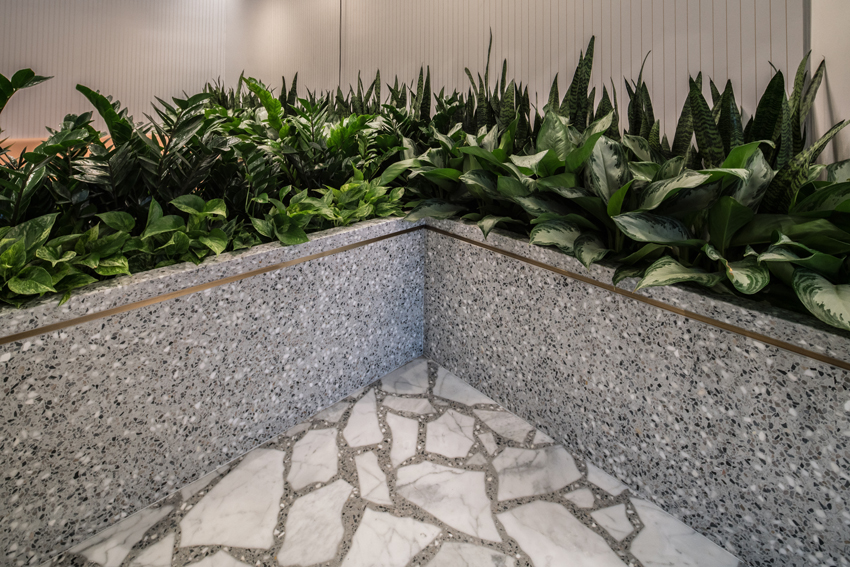Sustainable, Cost-Effective Renovations Using Terrazzo
Sustainability
Terrazzo is a sustainable option for many reasons, including the following:
- Natural materials: The aggregates are natural stone materials that can be responsibly sourced.
- Resin matrix: As an alternative to a cement matrix, epoxy (resin) terrazzo does not have the same embodied energy.
- Long life cycle: Terrazzo is a long-lasting and durable material that holds up to heavy foot traffic and other intense uses.
- Wellness: Terrazzo is nonporous and does not support microbial growth, nor does it allow moisture to accumulate, contributing to a mold-free, healthy environment. Additionally, terrazzo is comprised of little to no volatile organic comound (VOC) materials, and it exhibits little to no off-gassing over the life of the cured material.
- Ease of maintenance: As a very low-maintenance system, terrazzo can be cleaned with an environmentally friendly, neutral pH cleaner. This reduces or eliminates the need for harsh chemicals or cleaners that can irritate sensitive eyes or noses.

Terrazzo is made from natural materials and has many attributes that make it a sustainable choice for buildings.
Design and Performance Considerations
When considering the use of terrazzo for a sustainable building design, there are several key factors to recognize and keep in mind regarding both design and performance capabilities.
Design Versatility
Perhaps most appealing to many architects and interior designers is the versatility of terrazzo. The custom nature of terrazzo installations means that designs of all types, patterns, and colors can be incorporated into flooring, walls, stairs, platforms, balconies, countertops, walls, columns, or other surfaces. For example, imagery such as logos, government seals, mascots, maps, historical events, scientific facts, numbers, or other purposeful information can be displayed in the floor or walls of a lobby or public space. In large facilities, way-finding information can become part of the terrazzo design to help building users and visitors become oriented and find specific areas of a building. In other cases, a simple pattern can be used to create a subtle background for a space or for some featured coloring along a corridor or other circulation space. In short, the vast color, shape, pattern, and design options provide great freedom to create spaces that can meet virtually any design intent.
Performance
While some flooring and surface treatments might look good when first installed, their long-term performance may be lacking. Terrazzo, on the other hand, is well-known for its ability to hold up and continue looking great over the long term. In fact, there are numerous historic buildings that contain the original terrazzo flooring, which is still very successfully in use. In Oregon, for example, Portland’s Pioneer Courthouse boasts terrazzo floors dating from 1905. Further, terrazzo has been documented numerous times to withstand not only normal wear and tear but also dramatic events such as floods and hurricanes as well.
Among the many factors that contribute to the impressive performance of terrazzo are the following:
- Inherent strength: While it may be considered lightweight (3⁄8-inch epoxy terrazzo weighs approximately 4½ pounds per square foot), the aggregates and matrix binders are inherently strong materials. Terrazzo has been shown repeatedly that it can readily hold up to heavy foot traffic or other demands.
- Low maintenance: While regular cleaning is needed for any floor, the nonabsorbent surface keeps dirt and debris on top while resisting staining.
- Sanitary: In spaces where sanitary conditions are needed, the nonabsorbent surface also contributes to the ongoing likelihood of meeting these conditions.
- Epoxy enhancements: When epoxy terrazzo is used, color control, resiliency, chemical resistance, and tensile-compressive strengths are all increased compared with cement-based systems.

The Pioneer Courthouse in Portland, Oregon, has terrazzo floors that were installed in 1905 and continue in use today.
Dividers
Beyond the basic materials of the terrazzo, metal dividers are used for both design and performance reasons. As already noted, dividers can be set to separate colors or as an accent themselves. In these cases, the dividers are strictly decorative and related to the concrete slab or joints below it.
Beyond the decorative aspect, dividers are primarily used to maintain the integrity of the terrazzo over concrete. Their proper use and placement help overcome any potential cracking in the terrazzo. This is because terrazzo by itself is not likely to crack but can be impacted by the concrete substrate below it that, if it cracks, can telegraph up into the terrazzo surface. Therefore, the following should be kept in mind regarding the dividers:
- Concrete standard: To reduce the potential for cracking and therefore the terrazzo, ACI 302.1 R.89: Concrete Joint Placement must be followed.
- Location of dividers: Most systems adhere to the concrete and require dividers to be placed precisely above any concrete joints.
- Divider materials: Zinc and aluminum are standard, but brass and colored plastic are readily available.
- Size: Dividers vary in width from 18 gauge to 1⁄2 inch with 16 gauge or 1⁄8 inch as common standard sizes.
- Minimizing: In sanitary areas, terrazzo can be installed with minimal dividers, providing seamless characteristics.
Note that when dividers are used in conjunction with a flexible membrane as a specified extra, terrazzo can absorb some horizontal concrete crack or control joint movement. However, it is important to recognize that dividers do not function as leveling devices or crack preventers. Further, architects should design structural inset expansion plates between areas where major movement is anticipated.

Metal dividers in terrazzo flooring are used both to separate colors to create designs as well as to help overcome any cracking.










